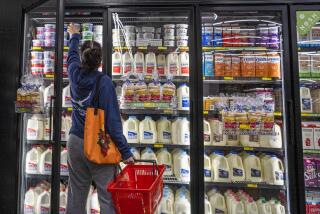Wholesale Prices Steady as Industrial Output Rises
- Share via
WASHINGTON — Wholesale prices were unchanged during January and industrial production showed an unspectacular but steady 0.4% increase, the government reported Friday, providing encouragement for the Reagan Administration and private economists who predict sustained growth and low inflation ahead.
“Another excellent report on inflation,” declared economist Allen Sinai of Shearson Lehman Bros., and he pronounced the industrial production figure “a very healthy sign.” Similarly, Robert Gough of Data Resources Inc., a Massachusetts economic forecasting firm, observed: “What is very encouraging is that these rates of growth in the economy and price increases are well within the sustainable range.”
White House spokesman Larry Speakes, with President Reagan in California, said that the reports reinforce “a . . . stream of good news that we have had over the last several months” that indicates the economic recovery and expansion are continuing.
Energy and food prices were sharply lower, offsetting a hefty 2.2% increase in auto prices, the Labor Department said in its monthly report on prices of finished goods at the wholesale level.
Two major categories--partly finished goods and raw materials--both showed price declines: a scant 0.1% for intermediate goods and 2.2% for materials. In particular, the latter statistic reflects the strong U.S. dollar’s impact on import prices of crude oil and other commodities in the international marketplace.
In a separate report, the Federal Reserve Board said that January’s overall rise in industrial production was led by strong increases in automobile production, energy materials and defense and space equipment.
Sinai said that the nation’s industries were recovering from inventory reductions forced by the mid-1984 economic slowdown, and he predicted that the building up of inventories “will permit sustainable growth easily through the first three quarters of the year.”
Higher Production Seen
Gough agreed, explaining that the increase in retail sales that occurred in December and January almost certainly would drive production higher as inventories fall.
“If demand continues at the rate we’ve been seeing, there is bound to be an increase in production,” Gough said. “You can’t support 4% and 4%-plus growth with production increase levels of just 0.4%.”
And Donald Ratajczak, director of the Georgia State University economic forecasting project, asserted: “A decline is now out of the cards, unless sales collapse, which I don’t see.”
Low Inflation Likely
Economists generally agreed that very low inflation is likely to continue--although perhaps not at the negative or near-negative rates shown in last month’s wholesale price report. Because of a normal one-month lag in energy price statistics, for example, the 2.7% and 2.3% decreases in gasoline and fuel oil costs reported in January actually reflect the sharp price breaks of December, and prices have steadied since then.
In addition, the sharp drop in food prices--including a 21.3% plunge in the cost of eggs--reflected a survey conducted before a late January freeze devastated much of Florida’s citrus-growing region.
“Food prices, because of the severe winter weather, are likely to show rises in the next two or three months, and oil prices have firmed recently,” Sinai said. “The dollar strength continues to be a major source of low inflation in the index, but I think the zeroes and negatives are behind us.”
Steep Auto Price Hike
The one discouraging sign in the January price index, the unexpectedly steep increase in new car prices, was in its own way a sign of economic strength. Buyer demand for U.S.-made cars has been unusually strong, and the price increase occurred even as car production increased a strong 6%, from an annual rate of 8.1 million to 8.6 million.
“Sales have been strong, demand high and inventories lean,” noted Gough, who termed the price increase an expected consequence of those conditions. And Ratajczak suggested that production increases in autos may be approaching the saturation point, saying: “At 8.6 million, you’d need to work Saturday and Sunday to do better than that.”
More to Read
Inside the business of entertainment
The Wide Shot brings you news, analysis and insights on everything from streaming wars to production — and what it all means for the future.
You may occasionally receive promotional content from the Los Angeles Times.










